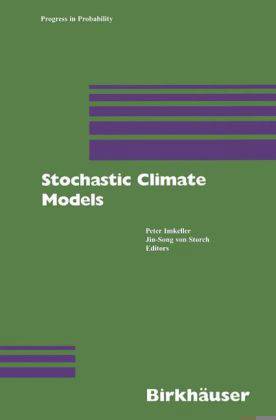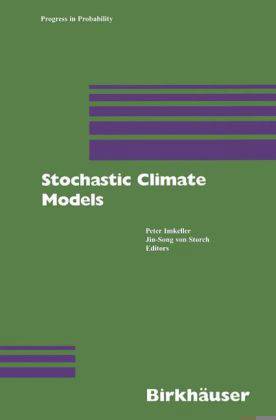
- Retrait gratuit dans votre magasin Club
- 7.000.000 titres dans notre catalogue
- Payer en toute sécurité
- Toujours un magasin près de chez vous
- Retrait gratuit dans votre magasin Club
- 7.000.0000 titres dans notre catalogue
- Payer en toute sécurité
- Toujours un magasin près de chez vous
Description
1 The Hierarchy of Climate Models.- A gallery of simple models from climate physics.- 1 Introduction.- 2 Fluid dynamics and thermodynamics.- 3 Reduced physics equations.- 4 Integrated models.- 5 Low-order models.- References.- Simple climate models.- 1 Climate and climate modelling.- 2 Zero-dimensional energy balance climate model.- 3 Quasi-geostrophic two-layer atmosphere in a channel.- 4 Reduced gravity ocean in a square basin.- 5 Summary and outlook.- References.- Complex climate models' tools for studying the origin of stochasticity in the climate system.- 1 Introduction.- 2 Origin of complexity.- 3 Cosequence of complexity.- 4 Concluding remarks.- References.- Some mathematical aspects of the GCMs.- 1 Introduction.- 2 Hierarchy of PDEs in the GCMs.- 3 The PEs and PEV2s of the ocean.- 4 The PEs and PEV2s of the atmosphere.- 5 Coupled atmosphere-ocean (CAO) models.- References.- 2 The Emergence of Randomness: Chaos, Averaging, Limit Theorems.- Hasselmann's program revisited: the analysis of stochasticity in deterministic climate models.- 1 Introduction.- 2 Stochasticity in deterministic climate models with two separate time scales.- 3 The method of averaging.- 4 Normal deviations from the averaged system: the central limit theorem.- 5 Large deviations from the averaged system.- 6 Extensions of Hasselmann's program comments.- References.- Thermodynamic formalism, large deviation, and multifractals.- 1 Expanding dynamical systems.- 2 Pointwise dimension.- 3 Multifractal formalism.- 4 Local large deviation.- References.- Summary.- Averaging and climate models.- 1 Introduction.- 2 The averaging setup.- 3 Fully coupled systems.- 4 Appendix A: hyperbolicity.- 5 Appendix B: Proof of Theorem 3.1.- 6 Appendix B: Proof of Theorem 3.2.- References.- Dynamical systems with time scale separation: averaging, stochastic modelling, and central limit theorems.- 1 Introduction.- 2 Average skill of an averaged model.- 3 Stochastic modelling.- 4 Central limit theorems and their limits.- Conclusion.- Appendix: Remarks on the numerical implementation.- References.- 3 Tools and Methods: SDE, Dynamical Systems, SPDE, Multiscale Techniques.- Energy balance models - viewed from stochastic dynamics.- 1 Introduction.- 2 The paradigm of stochastic resonance.- 3 Deterministic energy balance models.- 4 Stochastic extensions of EBM.- 5 Stochastic resonance: Freidlin's approach.- References.- Exponential stability of the quasigeostrophic equation under random perturbations.- 1 Introduction.- 2 Preliminaries.- 3 Transformation of the quasigeostrophic equation.- 4 The stationary solution.- 5 Discussion.- References.- A mini course on stochastic partial differential equations.- 1 Introduction.- 2 Cauchy problem and semigroups.- 3 Infinite dimensional Wiener processes.- 4 Stochastic integration.- 5 First order stochastic equations.- 6 Heat equation with space-time white noise.- 7 Stationary solutions of a wave equation.- 8 Nonlinear stochastic pdes.- 9 Appendix.- References.- Hasselmann's stochastic climate model viewed from a statistical mechanics perspective.- 1 Introduction.- 2 The microscopic description.- 3 The mesoscopic description.- 4 A derivation of the Langevin equation.- 5 The macroscopic description.- 6 Statistical mechanics.- 7 Discussion.- References.- 4 Reduced Stochastic Models and Particular Techniques.- Constrained stochastic forcing.- 1 Introduction.- 2 Charney-DeVore model.- 3 Discussion.- References.- Stochastic resonance and noise-induced phase coherence.- 1 Introduction.- 2 Stochastic resonance in the framework of synchronization phenomena.- 3 Conclusions.- References.- Stochastic confinement of Rossby waves by fluctuating eastward flows.- 1 Introduction.- 2 Spectral model.- 3 Superrotation flow.- 4 Interpretation.- 5 Conclusions.- References.- Some mathematical remarks concerning the localization of planetary waves in a stochastic background flow.- 1 Introduction.- 2 Some remarks concerning path properties of R.- 3 Transformation int...
Spécifications
Parties prenantes
- Auteur(s) :
- Editeur:
Contenu
- Nombre de pages :
- 432
- Langue:
- Anglais
- Collection :
- Tome:
- n° 49
Caractéristiques
- EAN:
- 9783764365202
- Date de parution :
- 11-05-01
- Format:
- Livre relié
- Format numérique:
- Genaaid
- Dimensions :
- 156 mm x 234 mm
- Poids :
- 775 g

Les avis
Nous publions uniquement les avis qui respectent les conditions requises. Consultez nos conditions pour les avis.






